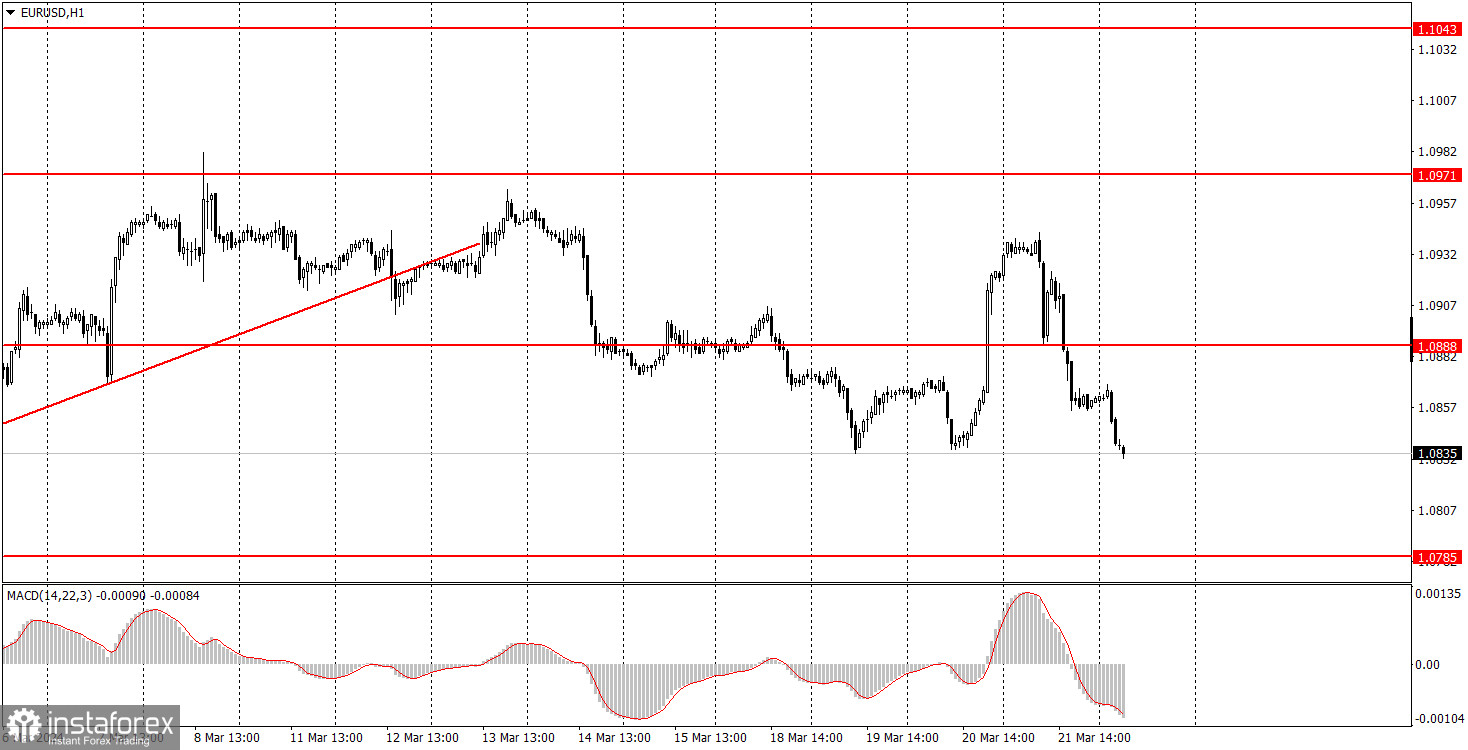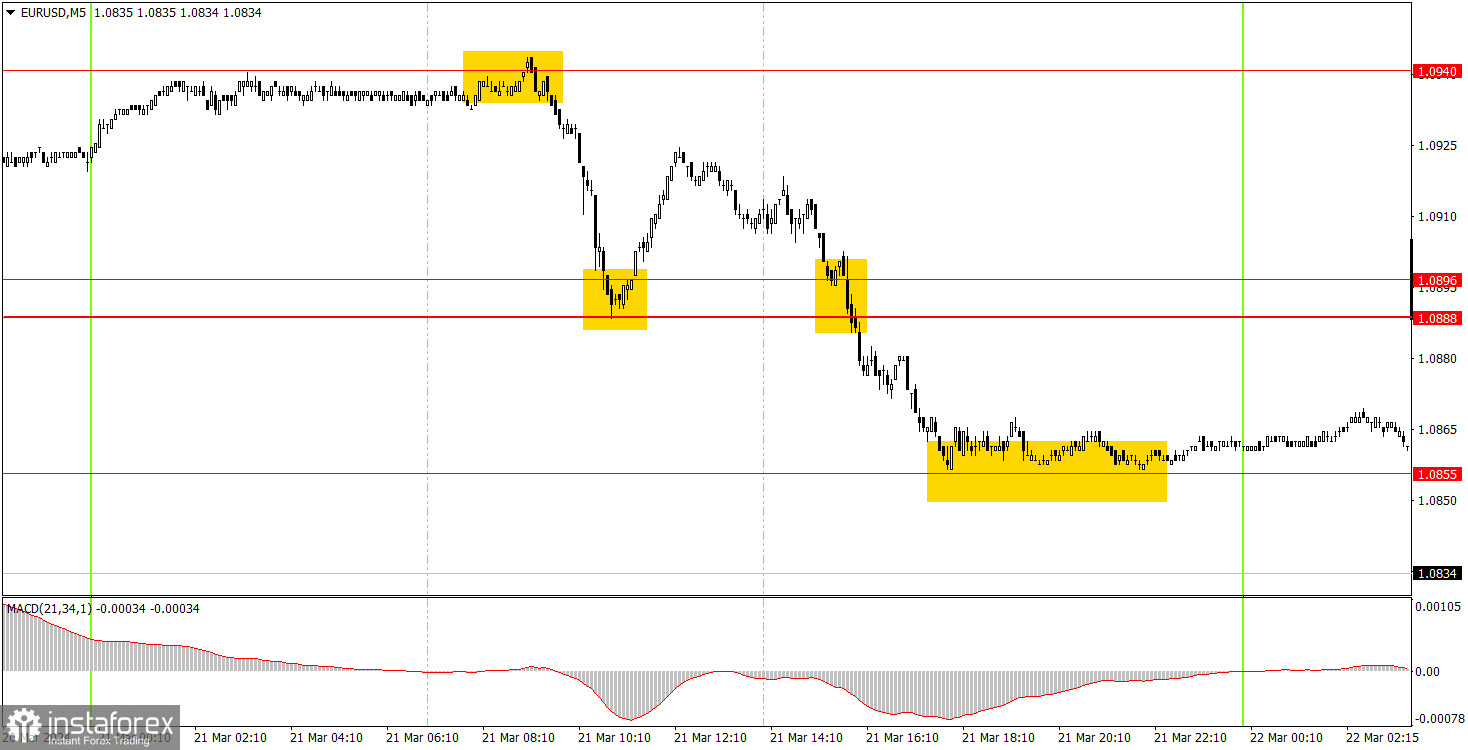Analyzing Thursday's trades:
EUR/USD on 1H chart

On Thursday, EUR/USD showed exactly the same movement we expected. I mentioned that we shouldn't immediately draw conclusions about the market's reaction to the Federal Reserve meeting. The market trades impulsively and emotionally at such times. Typically, it takes about a day for the situation to turn stable. As we can see, the day after the meeting, the pair started an equally strong decline, which continued overnight. This is because the Fed made no dovish decisions. Fed Chair Jerome Powell did not soften his stance compared to the previous meeting. On the contrary, inflation forecasts were slightly raised, and rate forecasts were slightly lowered. All this suggests that the US central bank has become even more hawkish, which should have triggered a dollar rise, not its fall. Thus, the downtrend persists.
EUR/USD on 5M chart

Practically all the signals on the 5-minute timeframe were strong and profitable. As soon as the pair began to move, rather than staying in one place, we saw several opportunities to make profit. Yesterday, an ideal bounce from the level of 1.0940 was formed, then an ideal bounce from the range of 1.0888-1.0896, followed by a breakthrough of the specified range. Of these three signals, only the second one did not lead to profit, but the long position triggered a Stop Loss to breakeven, as the price climbed by more than 15 pips. For the other two trades, traders could earn a total profit of about 40-45 pips.
Trading tips on Friday:
On the hourly chart, EUR/USD resumed its downward movement, which corresponds to this week's fundamental background. We believe that the euro should continue to fall. Unfortunately, the market doesn't always want to trade the pair in a logical manner, and from time to time, we observe unreasonable growth.
The key levels on the 5M chart are 1.0568, 1.0611-1.0618, 1.0668, 1.0725, 1.0785-1.0797, 1.0855, 1.0888-1.0896, 1.0940, 1.0971-1.0981, 1.1011, 1.1043, 1.1091. On Friday, the only report of the day is the business climate index in Germany - clearly a secondary report. The US economic calendar is quiet. Volatility may fall to the lowest levels, but the dollar may strengthen.
Basic trading rules:
1) Signal strength is determined by the time taken for its formation (either a bounce or level breach). A shorter formation time indicates a stronger signal.
2) If two or more trades around a certain level are initiated based on false signals, subsequent signals from that level should be disregarded.
3) In a flat market, any currency pair can produce multiple false signals or none at all. In any case, the flat trend is not the best condition for trading.
4) Trading activities are confined between the onset of the European session and mid-way through the U.S. session, after which all open trades should be manually closed.
5) On the 30-minute timeframe, trades based on MACD signals are only advisable amidst substantial volatility and an established trend, confirmed either by a trendline or trend channel.
6) If two levels lie closely together (ranging from 5 to 15 pips apart), they should be considered as a support or resistance zone.
How to read charts:
Support and Resistance price levels can serve as targets when buying or selling. You can place Take Profit levels near them.
Red lines represent channels or trend lines, depicting the current market trend and indicating the preferable trading direction.
The MACD(14,22,3) indicator, encompassing both the histogram and signal line, acts as an auxiliary tool and can also be used as a signal source.
Significant speeches and reports (always noted in the news calendar) can profoundly influence the price dynamics. Hence, trading during their release calls for heightened caution. It may be reasonable to exit the market to prevent abrupt price reversals against the prevailing trend.
Beginning traders should always remember that not every trade will yield profit. Establishing a clear strategy coupled with sound money management is the cornerstone of sustained trading success.





















